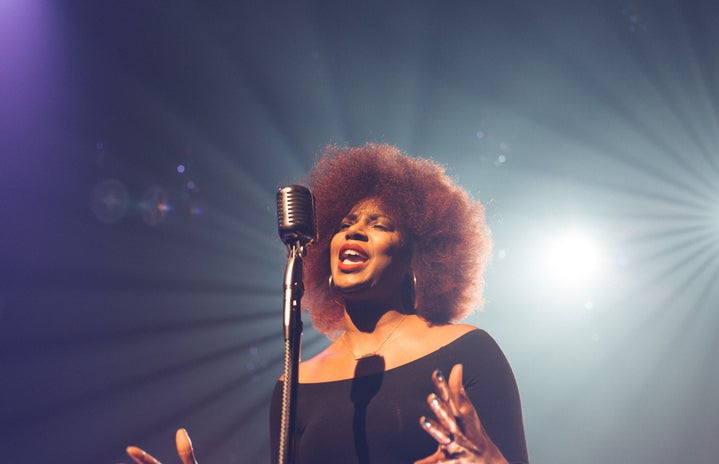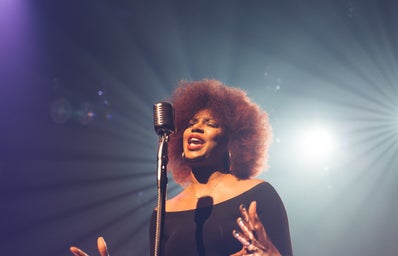I read this book for my Afro-Am 156 class — Revolutionary Concepts in African American Music (II); highly recommend taking the class btw. I’ve always loved music, and specifically the blues because I started playing the saxophone at a young age. I focused a lot of my time playing jazz and blues, but I had never taken the time (nor had I heard of books) to read about blues. When we were assigned readings that specifically focused on blues women, I was extremely eager to learn more about the history of the music that I’d listened to and played.
Here are just a few quotes that replay in my head and may inspire you to read Angela Davis’ Blues Legacies and Black Feminism.
- “By virtue of their femaleness, they faced ideological expectations of domesticity and subordination emanating from the dominant culture. On the other hand, given the political, economic, and emotional transformation occasioned by the disestaablishmentof slavery, their lived experiences rendered ideological assumptions flagrantly incongruous. In the blues, therefore, gender relationships are stretched to their limits and beyond. A typical example of this is one of Bessie Smith’s early songs, “Mistreatin’ Daddy” (22).
-
Blues women, by virtue of existing, pushed against all forms of dominating power structures. The abolition of slavery put into place a completely new existence and terrain for the black community to define for themselves. Oftentimes, the dominating (white) culture offered little direction as black lived experiences rendered white understandings incompatible with the realities of black communities. Blues women were able to explore freedom, individuality, and autonomy through their music. It was also a way to vocalize and share their lived experiences with other black audiences. Black women, from the beginning, stretched the ideas and understanding of love, gender, and sexuality to their extreme; this is important because I feel that many people see movements that call for sexual liberation, gender inclusivity, and the like as fairly recent — but when we look at black history, specifically the history of black women blues artists, these concepts that are still “radical” today, were being addressed very explicitly in the early-mid 1950s.
Bessie Smiths’ “Sam Jones Blues” utilizes language that “mocks the dominant white culture as she highlights cultural contradictions that black women experienced when comparing their own attitudes toward love and sex with the idealization of the domminant culture” (24).
- “Fearless, unadorned realism is a distinctive feature of the blues. Their representations of sexual relationships are not constructed in accordance with the sentimentality of the American popular song tradition. Romantic love is seldom romanticized in the blues. No authentic blues women could, in good faith, sing with conviction about a dashing prince whisking her into the “happily-ever-after” (23).
-
To an extent, Blues women could not speak of fantastical love stories, as Black women never had the ability to embody femininity, and love in relation to that femininity, the same way white women were. Black women worked alongside Black men, and after the abolition of slavery, were forced to navigate (Black) love in a way that simply could not take from white understandings of love. Because of this, their music embodies their lived experience as they navigate their experiences with love and sexuality — Blues women vocalized that men are not paragons of perfection and had no qualms about announcing female desire.
- “Classic blues comprised an important elaboration of black working-class social consciousness. Gertrude Rainey and Bessic Smith’s songs constituted historical preparation for social protest. They also foreshadowed a brand of protest that refused to privilege racism over sexism, or the conventional public realm over the private as the preeminent domain of power. Because women’s blues were not ideologically structured by the assumptions that defined the prominent black women’s organizations of the era as middle-class, they could issue more direct and audacious challenges to male dominance” (42).
-
Blurring the line of the “public” and “private” realm is, what I feel, one of the most revolutionary concepts within blues music. Black feminism was able to identify and call out problems that were stereotypically meant to stay in the “private realm.” Black women simultaneously face(d) racism and sexism — the refusal to privilege one over the other was an extreme push back against dominating structures. And to an extent, this may be why Blues women are not spoken about or highlighted as often; they pose a very real threat to cis-heteropatriarchial ideals, white supremacy, and capitalism. To do this, even today threatens almost all existing power structures. No wonder, then, they are not talked about more often.
- “It is important, I think, to understand women’s blues as a working-class form that anticipates the politicization of the “personal” through the dynamic of “consciousness-raising,” a phenomenon associated with the women’s movement of the last three decades” (42).
-
Class dynamics become increasingly important to understand when looking at early female Blues singers. Blues women were often working-class and sang about their lived experience and articulated their desires. They created an understanding of sexual agency and found freedom in doing so (this is not to say that women Blues singers were not at harm because of this though). Blues was one of the few realms in which masses of “African American women could exercise autonomy — and thus tangibly distinguish their contemporary status from the history of enslavement” (44).
It’s also about what is not being said in the Blues; they’re not singing about “Middle-class women’s ideals” and don’t bring up domesticity. This ability to define on their own terms wants, and desires is fundamental to understanding what is said in the blues and who they are talking to.
- “Through the Blues, Black women were able to autonomously work out — as audiences and performers — a working-class model of womanhood. This model of womanhood was based in part on a collective historical memory of what had been previously required of women to cope with slavery. But more important, it revealed that Black women and men, the Blues audience, could respond to the vastly different circumstances of the postslavery era with notions of gender and sexuality that were, to an extent, ideologically independent of the middle-class cult of “true womanhood” (46).
-
Blues women were able to create an understanding of their desires as working-class individuals that, in some instances, rejected ideas and notions of wanting to rise into middle-class society. It broke away from stereotypes of what “true womanhood” should be and constructed an understanding that was solely based on their needs and wants. Blues was made for a working-class audience by working-class performers. These women were pushing against class ideologies and the inherent dangers of capitalism even before scholars could conceptualize and study these ideas. To an extent, they were speaking their truth, but they were speaking a truth that really didn’t care about what others’ thought or said. It’s revolutionary — they’re revolutionary.
- “I want to emphasize woman’s Blues as an important cultural mediator for this gendered consciousness that transformed collective memories of slavery as it worked a new social construction of love and sexuality. The Blues provided a space where women could express themselves in new ways, a space in which they sometimes affirmed dominant middle-class ideology but also could deviate from it” (47).
-
Woman’s Blues does not play just a small part within history nor in its effects on feminism today — it is a large part of creating an increased gendered consciousness “That transformed collective memories of slavery as it worked a new social construction of love and sexuality.” To misunderstand or not credit blues women is doing a major disservice to black feminism today. They are vital.
This book doesn’t just speak about music. It is radical even in the acknowledgment of Black women in Blues, and I highly recommend that you check it out or check out some early Blues music. And if you do want to check out some music, here are a few songs that I like:
- Ma Rainey, “Prove It On Me Blues”
- Bessie Smith, “St. Louis Blues”
- Bessie Smith, “‘Tain’t Nobody’s Business If I Do”
- Ma Rainey, “Blame It On The Blues”
Enjoy!



